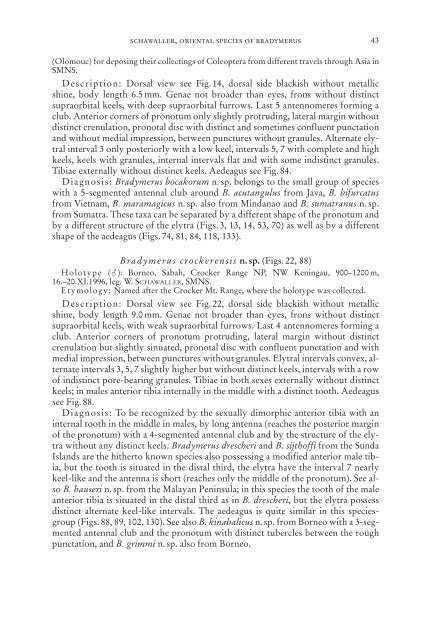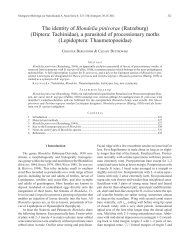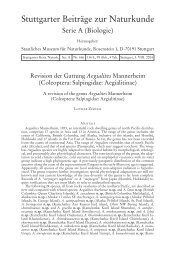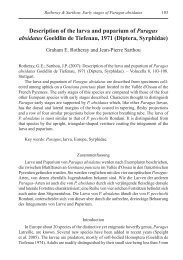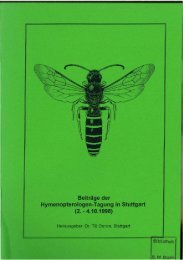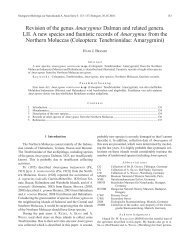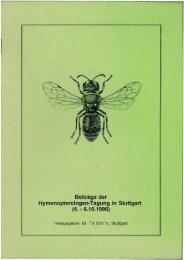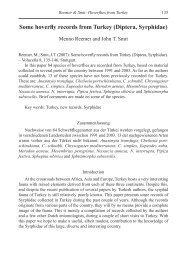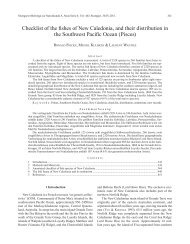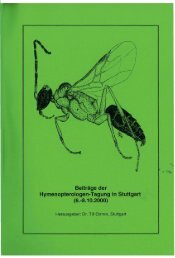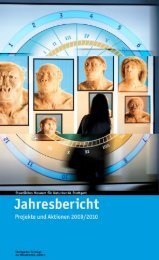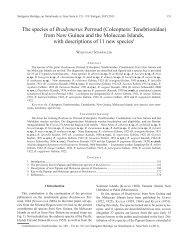Serie A (Biologie) - Staatliches Museum für Naturkunde Stuttgart
Serie A (Biologie) - Staatliches Museum für Naturkunde Stuttgart
Serie A (Biologie) - Staatliches Museum für Naturkunde Stuttgart
Create successful ePaper yourself
Turn your PDF publications into a flip-book with our unique Google optimized e-Paper software.
schawaller, oriental species of bradymerus 43(Olomouc) for deposing their collectings of Coleoptera from different travels through Asia inSMNS.Description: Dorsal view see Fig. 14, dorsal side blackish without metallicshine, body length 6.5 mm. Genae not broader than eyes, frons without distinctsupraorbital keels, with deep supraorbital furrows. Last 5 antennomeres forming aclub. Anterior corners of pronotum only slightly protruding, lateral margin withoutdistinct crenulation, pronotal disc with distinct and sometimes confluent punctationand without medial impression, between punctures without granules. Alternate elytralinterval 3 only posteriorly with a low keel, intervals 5, 7 with complete and highkeels, keels with granules, internal intervals flat and with some indistinct granules.Tibiae externally without distinct keels. Aedeagus see Fig. 84.Diagnosis: Bradymerus bocakorum n. sp. belongs to the small group of specieswith a 5-segmented antennal club around B. acutangulus from Java, B. bifurcatusfrom Vietnam, B. maramagicus n. sp. also from Mindanao and B. sumatranus n. sp.from Sumatra. These taxa can be separated by a different shape of the pronotum andby a different structure of the elytra (Figs. 3, 13, 14, 53, 70) as well as by a differentshape of the aedeagus (Figs. 74, 81, 84, 118, 133).Bradymerus crockerensis n. sp. (Figs. 22, 88)Holotype (): Borneo, Sabah, Crocker Range NP, NW Keningau, 900–1200 m,16.–20.XI.1996, leg. W. SCHAWALLER, SMNS.Etymology: Named after the Crocker Mt. Range, where the holotype was collected.Description: Dorsal view see Fig. 22, dorsal side blackish without metallicshine, body length 9.0 mm. Genae not broader than eyes, frons without distinctsupraorbital keels, with weak supraorbital furrows. Last 4 antennomeres forming aclub. Anterior corners of pronotum protruding, lateral margin without distinctcrenulation but slightly sinuated, pronotal disc with confluent punctation and withmedial impression, between punctures without granules. Elytral intervals convex, alternateintervals 3, 5, 7 slightly higher but without distinct keels, intervals with a rowof indistinct pore-bearing granules. Tibiae in both sexes externally without distinctkeels; in males anterior tibia internally in the middle with a distinct tooth. Aedeagussee Fig. 88.Diagnosis: To be recognized by the sexually dimorphic anterior tibia with aninternal tooth in the middle in males, by long antenna (reaches the posterior marginof the pronotum) with a 4-segmented antennal club and by the structure of the elytrawithout any distinct keels. Bradymerus drescheri and B. sijthoffi from the SundaIslands are the hitherto known species also possessing a modified anterior male tibia,but the tooth is situated in the distal third, the elytra have the interval 7 nearlykeel-like and the antenna is short (reaches only the middle of the pronotum). See alsoB. hauseri n. sp. from the Malayan Peninsula; in this species the tooth of the maleanterior tibia is situated in the distal third as in B. drescheri, but the elytra possessdistinct alternate keel-like intervals. The aedeagus is quite similar in this speciesgroup(Figs. 88, 89, 102, 130). See also B. kinabalicus n. sp. from Borneo with a 3-segmentedantennal club and the pronotum with distinct tubercles between the roughpunctation, and B. grimmi n. sp. also from Borneo.


